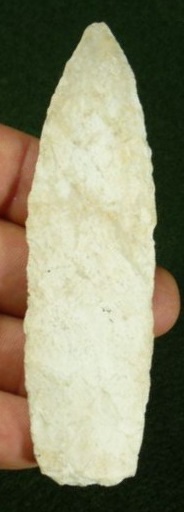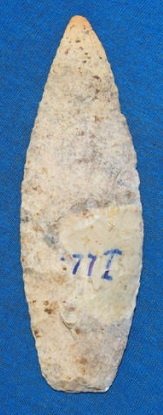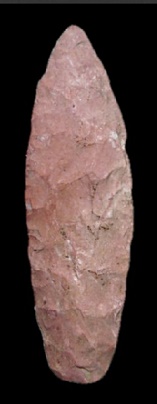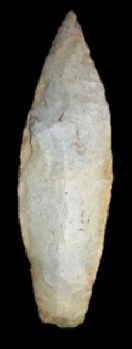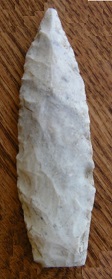Name Details:
Named By: Robert M. Seeland / Chapman
Named For: Type Site
Date Identified: 1961 / 1975
Type Site: Sedalia Site, Pettis County, Missouri
Sedalia
Cluster: Nebo Hill Cluster
Commonly Utilized Material:
non-heat treated Burlington chert
Date:
Cultural Period:
4,000 - 3,000 B.P.
Late Archaic
Neoglacial
Sedalia Complex
Glacial Period:
Complex:
Outline is Representative of Size and Shape:
Description of Physical Characteristics and Flaking Pattern:
This is a
thick medium to large lanceolate point with an elliptical cross section. The blade is excurvate with the widest portion of the blade being most commonly
at or above the
mid-point of the blade. The base varies from
slightly convex to slightly concave.
Basal and lateral hafting edge grinding is most commonly absent, but
occasionally light lateral edge hafting grinding may be present.
Basal thinning is commonly absent. This point
was manufactured using broad percussion flaking with minimal
pressure flaking forming a random flaking pattern.
Size Measurements: Total Length -
76 to 204 mm (average 100 to 150 mm commonly 3 time the length of
the width), Blade Width - 22
to 40 mm (average 25 to 29 mm) Basal Width -
10 to 22 mm
Distribution:
Distribution Comments:
This point has the heaviest concentrations in the east central Missouri and west central Illinois. They may be found with less frequency into western Indiana, western Kentucky, and southern Iowa. This point has rarely been reporting
into southern Minnesota.

Related / Associated Points:
Additional Comments:
Sedalia share many characteristics with Nebo Hill points.
However, Nebo Hill points tend to be somewhat smaller and narrower with more
pressure retouch and a thick, almost diamond-shaped cross section (Morrow,
2016).
This point is wider and is not as thick as the Nebo Hill point (W2).
Point Validity: Valid Type
This type was named in a
professional publication and has many professional references. This is considered a valid type.
.
Age Details:
This point type is diagnostic of the Sedalia
Complex in Missouri where they date from 2700 to 1900 B.C.E. (Harl 2009),
and the Late Archaic Titterington phase in the lower Illinois Valley, where
it they are dated to 2200 to 1800 B.C.E. (Wiant et al. 2009) (Morrow, 2016).
References: (See Reference Page, Entry Number):
23, 30, 37, 168, 179, W2
Sedalia Projectile Point, Sedalia Arrowhead




